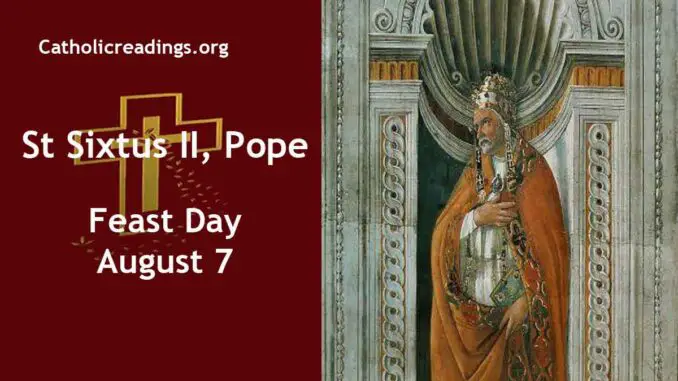St Sixtus II, Pope and Martyr, and Companions, Martyrs
Pope Sixtus II was born in Greece in the Roman Empire in the early 3rd century AD.
He was the bishop of Rome and pope from August 31 257 until his martyrdom on August 6 258.
He was martyred during the Valerian persecution together with seven deacons, including St Lawrence of Rome.
His feast day is celebrated together with that of his companions on August 7 every year in the Catholic Church.
| St Sixtus II, Pope and Martyr, and Companions, Martyrs Biography | |
|---|---|
 |
|
| Date of Birth | Early 3rd century AD |
| Place of Birth | Greece |
| Profession | Pope and Bishop of Rome |
| Place of Work | Rome |
| Date of Death | August 6 258 |
| Place of Death | Rome, Italy |
| Feast Day | August 7 |
| Canonization | By Pre-Congregation |
St Sixtus II, Pope, and Companions, Martyrs Life History
The word Sixtus is the Latin word for Sixth. The first sixth pope reigned from 115-125 AD. Our today’s saint is the second sixth pope, Pope Sixtus II, whose papacy began on August 31 257 AD and ended one year later on August 6 258 AD.
In the mid 3rd century, the Roman Emperors Decius and Valerian were very much against Christianity and began to persecute Christians, especially the Popes, Bishops, Priests, and deacons.
Emperor Decius (from 250–251) required that every resident in the Roman Empire sacrifice to a Roman god and after the sacrifice be issued with a certificate of compliance.
There were Christians who out of death threats sacrificed to the gods, others bought the certificates of compliance while others fled their dwellings to the rural areas for safe hiding, and the rest who adamantly refused to sacrifice were martyred in cold blood.
There emerged divisions in the Church over the manner of readmitting the Christians who had sacrificed to the Roman gods.
The Church in Africa and Asia was adamant that those Christians must be rebaptized while Pope Sixtus II predecessor, Pope Saint Stephen I, was categorical that those Christians only needed to repent to be accepted back to the Church.
It was Pope Sixtus II who was able to resolve this conflict and restored the relations with the African and Eastern churches.
After the martyrdom of Pope Saint Stephen I, Pope Sixtus II was consecrated in secret away from the prying eyes of Emperor Valerian.
Initially, the emperor was calm but in 258 he changed and started persecuting Christians. He forbade them from gathering in cemeteries and targeted the Church leaders, that is Bishops, priests, and deacons who would be killed even without a trial.
One night, on August 6 258, in an underground chapel near the cemeteries, Pope Sixtus II was celebrating mass, and unfortunately, there were Roman soldiers patrolling nearby and heard sounds coming from the cemetery.
They went there and found the pope with his flock. They killed Pope Sixtus II together with six deacons namely; Januarius, Vincentius, Magnus, Stephanus, Felicissimus and Agapitus.
The rest of the flock was allowed to walk away unharmed. St Lawrence of Rome, the pope’s best-known deacon, met his martyrdom four days later on August 10 258.
St Sixtus II, Pope Feast Day
The feast day of Saint Sixtus II, Pope, and Companions, Martyrs is celebrated on August 7 every year in the Catholic Church. Initially, before 1969, it was celebrated on August 6.
Related Links
Powered By SEO Experts
Follow @ReadingCatholic
